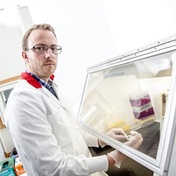More than a dozen children with so-called "bubble boy" disease are alive and well, with functioning immune systems, nine years after undergoing gene therapy to correct their disorder, researchers report.
Most of the patients attend school with other children, something that probably would have been fatal without treatment.
"The promise of gene therapy is being fulfilled, at least for these diseases, where a number of patients are walking around in good health because they had gene therapy," said Dr Donald Kohn, professor of microbiology, immunology and molecular genetics and paediatrics at the University of California, Los Angeles.
The disorder - severe combined immunodeficiency (SCID) - compromises the immune system so severely that children can't fight off normally innocuous infections. The condition is rare, and the term "bubble boy" was coined after a Texas boy with the condition lived in a germ-free plastic bubble.
Only boys inherit the gene in question, and many born with SCID die in infancy.
SCID and therapy
Two studies published in Science Translational Medicine detail the results of the gene-modifying treatment. Kohn wrote a perspective piece accompanying the studies.
Traditionally, the only treatment for SCID was stem cell transplantation in which immune cells from a matching donor are transferred to the patient. But it's difficult to find matching donors and, even then, the patient's body may reject the transplanted cells.
With gene therapy, clinicians remove the patient's own bone marrow, isolate the stem cells, correct the gene and reinsert it into the patient, explained William J. Bowers, associate professor of neurology at the University of Rochester Medical Center in Rochester.
The two current papers detail the success of gene therapy in two groups of patients: 10 boys with X-linked SCID (SCID-X1); and six with ADA-SCID, which involves a slightly different gene mutation. All were between six months and 39 months old.
Gene therapy successfully treated four of the six ADA-SCID patients.
All the SCID-X1 children recovered, although one developed leukaemia. That boy is currently in remission, but leukaemia has been a problem with previous gene therapy trials.
Last year, French researchers reported that eight of nine male infants born with SCID-X1 had recovered as a result of gene therapy. Unfortunately, almost half developed acute leukaemia, one of whom died.
The virus vector used in this earlier trial inadvertently activated an oncogene, which led to the development of the leukaemia, researchers said.
The latest research circumvented this problem by using a different virus vector.
"A cloud was thrown over the field several years ago and they've solved it nicely," said Dr Darwin Prockop, director of the Texas A&M Health Science Center College of Medicine Institute for Regenerative Medicine at Scott & White in Temple, Texas. "Very probably this can be used for other genetic diseases."
"This field came on with huge promise, then hit a few bumps and now . . . we're starting to see more and more of these successes," added Bowers.
More information
The U.S. National Human Genome Research Institute has more on SCID.
(Copyright © 2010 HealthDay. All rights reserved.)




 Publications
Publications
 Partners
Partners











